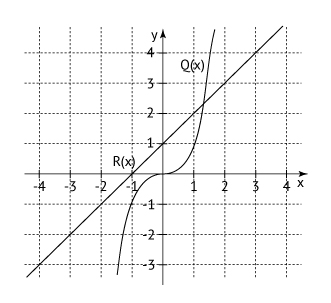O polinômio P(x) = x3 - x - 1 tem uma raiz real r tal que:
1ª forma de resolução:
Para qualquer função polinomial p, se p(a) e p(b) tiverem sinais contrários, então p tem pelo menos uma raiz real entre a e b. As figuras a seguir ilustram essa afirmação em diferentes casos através do gráfico de p:

No caso específico do polinômio  , tem-se (valores escolhidos em função das alternativas):
, tem-se (valores escolhidos em função das alternativas):

Como P(1) e P(2) têm sinais contrários, pode-se concluir que P tem pelo menos uma raiz real r tal que 1 < r < 2.
Resposta: alternativa B
2ª forma de resolução:
As raízes de P(x) são dadas pela equação:

a qual pode ser reescrita como:

Resolver essa última equação equivale a encontrar as abscissas dos pontos de interseção dos gráficos dos polinômios  . Esboçando-se ambos em um mesmo plano cartesiano, tem-se:
. Esboçando-se ambos em um mesmo plano cartesiano, tem-se:

Pela figura, conclui-se que os gráficos se intersectam em apenas um ponto, de abscissa entre 1 e 2.
Resposta: alternativa B